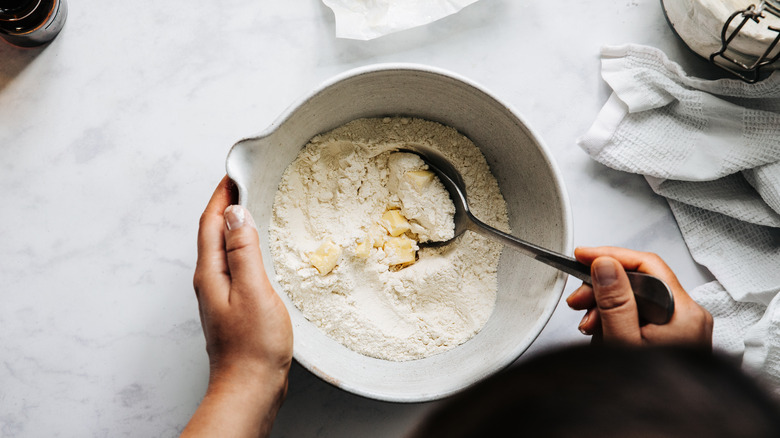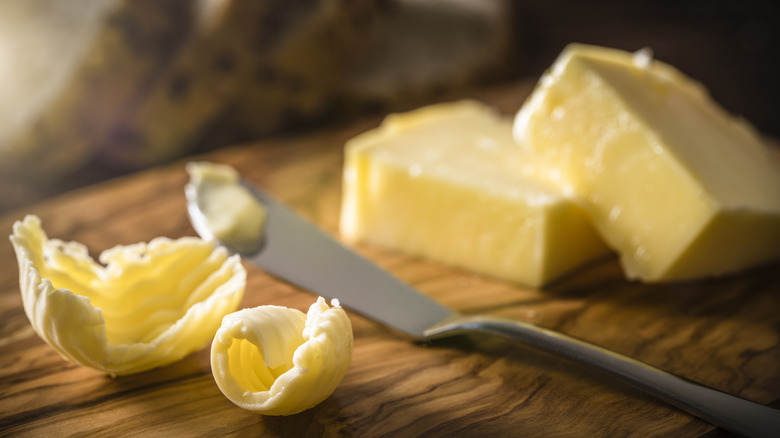Martha Stewart's Key To Better Pies Is All In The Butter
When she's not shooting viral lighter commercials with Snoop Dogg and posting fire Instagram photos, Martha Stewart is doling out fantastic culinary wisdom. Her most recent tip was directed toward the realm of pie-making, a notoriously tricky affair. Luckily, Stewart cuts through all the noise and claims that the perfect pie crust is attainable as long as you go for high-quality butter. So, what exactly does that entail?
Let's analyze the two butter brands that Stewart has name-dropped: Vermont Creamery and Kerrygold. Both qualify as European-style butter (even though one is actually made in the U.S.), as opposed to American-style or commercial butter. The distinction between the two kinds of butter comes down to the butterfat content. The USDA requires 80% butterfat to be present in butter, while European standards expect 82% to 90% butterfat. Like with laminated pastries, a pie crust benefits from a higher fat content because it creates numerous flaky layers within the dough when subjected to the high heat of the oven.
Another important distinction for these two brands is that they are cultured butter, which means they have a touch of tangy fermentation added to the mix. This impacts the flavor and provides a sophisticated, acidic taste. Speaking of flavor, Stewart likes to stick with the unsalted butter varieties so that she can better control the salt content in her dough. With these three features, her butter of choice makes a significant difference to her pie dough.
Working with higher fat butter
If you're going to use high-quality butter, there are a few tips you need to keep in mind. First, because it has a higher fat content, this type of butter is more prone to melting. To combat this temperature sensitivity, make sure your hands and utensils are as cold as possible. You can plunge your hands into an ice bath and freeze your bowl, whisk, and other utensils before starting to keep everything cool. You should also refrigerate the pie dough in between rollouts if you feel it getting too soft.
Another adaptation you'll need to account for is the salt level. As the butter is unsalted, you'll need to compensate for this lack of salt in the dough by adding a bit on your own (½ teaspoon of kosher salt is a good place to start). As for baking, you may notice that your pie dough bakes and browns faster than with a lower-fat-content butter. Just be sure to keep an eye on your dough during parbaking, pulling it out just when the edges turn brown.
More great uses for European-style butter
There are plenty of other baked goods that could do with this quality butter swap as well. Start with recipes that rely heavily on the rich butter flavor, like shortbread cookies and yellow butter cake. It's also an excellent option for any laminated pastries, like croissants and kouign-amann. And don't get us started on the benefits of serving your freshly baked bread with proper European-style butter. Spoiler: it'll change your life.
Although this butter swap often leads to tasty results, it can be a case of "too much of a good thing." As the European-style butter has much less water and more fat than the alternative, it can occasionally turn your baked good into a greasy, crumbly mess. So, if the original recipe is reliant on American-style butter, you should adjust your ratios slightly. To properly swap it in, reduce the butter amount by ¼. For example, if the recipe calls for 1 cup of American-style butter, use ¾ cup of European-style butter. With that one rule in mind, you can begin exploring the richer side of baking through European-style butter.



